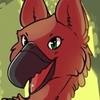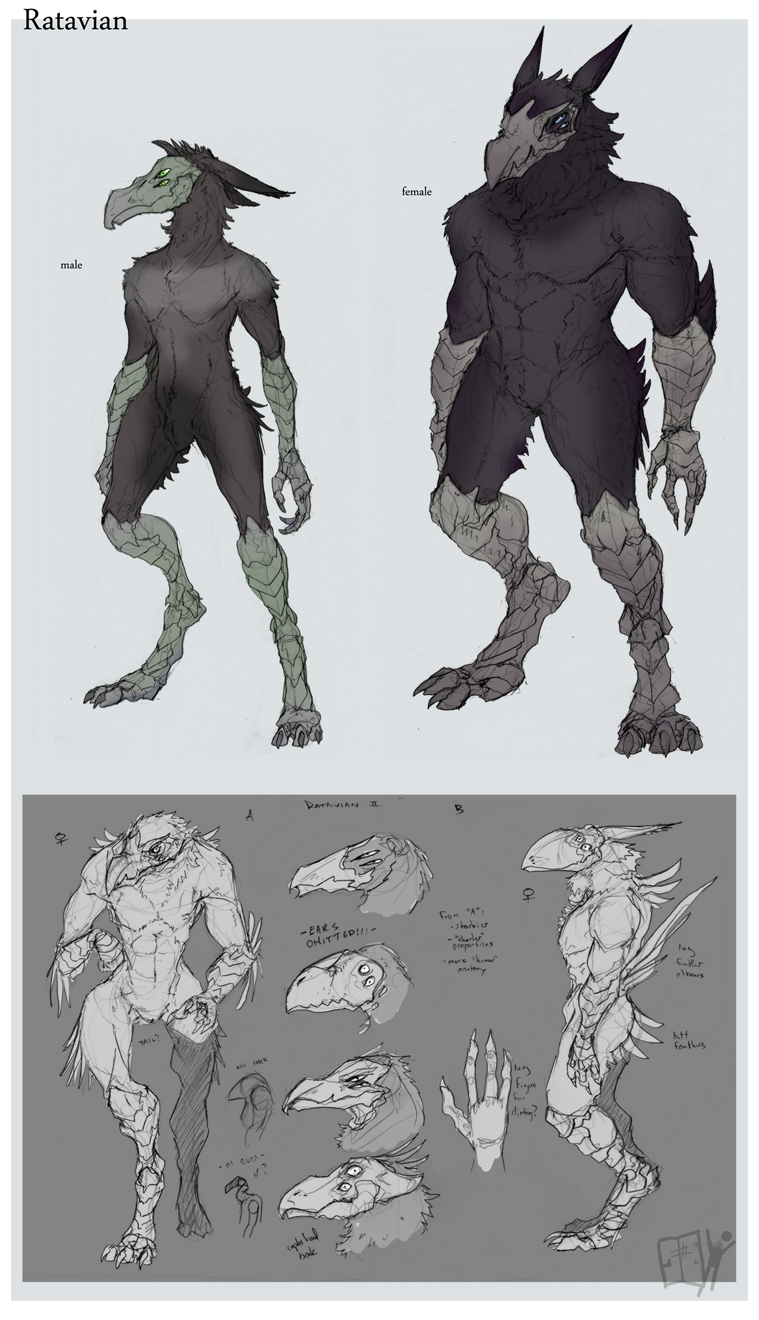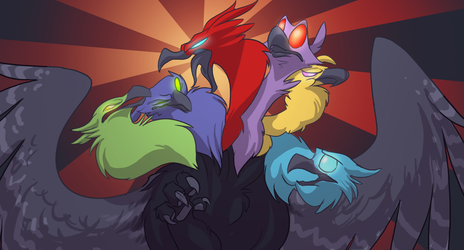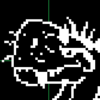Sign In
CloseThis is the result of me kicking around the concept of a sci-fi race in my head for a while. I started off with the concept of having a female-dominant society and went from there, pretty much. I also wanted something that breathes something different from humans (in the case of Ratavians, the atmosphere they breathe is a mix of Argon, Nitrogen, and Chlorine, along with sulfur particles). While this doesn't include all the little details about them, I think it's a good enough summery of the various aspects of the Ratavians, at least I hope so given its length... Regardless, I hope you find this interesting both to look at and/or read!
I certainly love how this came out, and I hope to get more pics of these guys sooner rather than later! :D
Concept Art by breaker
Race Concept by Sparra
General Description
With large, prominent beaks and scaled limbs, the omnivorous Ratavians are relative newcomers to the galactic community, having been known for less than a forty years. During the first two decades of being discovered (in what would become the First Contact War, a conflict which nearly wiped out Ratavians as a whole), Ratavians have progressed from the human equivalent of 1940s technology to being an FTL-capable race, which then took on the United Terran Federation (a major human-dominated faction that expanded into Ratavian-controlled space via corporate expansion) in what would become known as the Great War, and over a period of 4 years the Ratavians not only won back their territory, but also outright forced the UTF to sue for peace (triggered by the loss of a Dreadnought-class warship, one of 6 in the Federation Fleet, after a two-year siege).
Their homeworld, named Ratavia, is a craggy, mountainous world with an atmosphere primarily composed of Argon, Nitrogen, and Chlorine, along with Sulfur particles. With very little water, the climate of a given area is determined primarily by altitude. High altitudes are cold and devoid of life, while low altitudes are riddled with lakes of lava and are extremely hot thanks to Ratavia's hot core and relatively thin crust. Thus, a "green band" of life exists, where the vast majority of Ratavian cultivation takes place. Ratavians themselves live in the sides of hills and mountains adjacent to these cultivated lands (and in areas unable to be used as such) in order to conserve what limited space there is. The radiation levels of Ratavia are extremely high as the planet, while capable of holding onto an atmosphere, is unable stop the sheer amount of radiation (including UV radiation and EMP) that bombards the planet, and most life have adapted to this in a variety of ways.
Physical Characteristics
Ratavians are omnivorous cliff-dwellers by nature, with a prominent, powerful beak and two pairs of eyes. This beak, while powerful enough to allow Ratavians to crush through shells and bones, also gives Ratavians a blind spot directly forward of their face. However, their dual sets of eyes give Ratavians a large range of binocular vision, and nearly 360 degree peripheral vision, but they're unable to move and focus each set of eyes independently (unlike chameleons). Unable to see reds and oranges, a Ratavian's eyes are able to see using UV light. Ratavians are closer related to birds and reptiles than mammals, as demonstrated by their lack of breast-feeding and reproduction with eggs. Their forearms down to their hands are covered in heavy scales, with tough, leathery skin on their palm. Strong climbers, hailing from a planet covered in mountains, valleys and cliffs, their strong, digitigrade legs end in a similar fashion to their arms, the shins down also covered in heavy scaling and tipped with pronounced talons. The rest of their body is covered in feathers with a layer of short fur serving as an undercoat. This coat tends to be neutral shades, ranging from browns and creams as well as whites, grays and blacks (and everything in between, including patterns, though pure white/black is less common).
Female Ratavians stand anywhere between 7 to 8 feet tall, while males stand at 6 to 7 feet tall. Female Ratavians have a bulkier, stronger build than their male counterparts, their four-digit hands ending in heavy, strong claws, with males having smaller, less pronounced claws. Ratavians lay eggs in clutches of 2-4, which are carried by the mother internally for 90 days, laid, then after an additional 30 days hatch (it's worth nothing that Ratavian eggs are fairly resilient to changes in temperature, and don't require a narrow range of temperature to develop). During their pregnancy a female Ratavian actually isn't hindered at all by the additional load, quite the opposite. As their hormone level increases, a pregnant Ratavian experiences a widening of the hips, increased muscle growth, and mood changes (shifting to be more aggressive and protective of their eggs and any they consider under their care as well as overall more temperamental). This prevents a situation where a population of Ratavians collapse due to most of the females being pregnant (as females are the primary food-bringers, not the males). A male Ratavian's genitals (including testes) are internal, stored in a pouch until needed (due to an increase of blood-flow to the area, this also exposes a male's testes from pouch as an act of temperature regulation of the sperm). More than just physical protection, the pouch also helps shield Ratavian sperm from the extremely high ambient radiation of their environment, even if it makes a male's crotch area bulkier.
Sexually Dimorphic Traits
The sexual dimorphism that Ratavians display isn't natural. Early on in Ratavian history, they figured out that they could apply the same methods of animal husbandry to their own kind, which go on to this day. Specifically, female Ratavians began a long process of selective breeding and eugenics (which continue to this day) on the males, breeding for docility, fertility, and pleasure, which resulted in the fairly dramatic difference between male and female Ratavians. These traits go beyond physical however, as male Ratavians are far more docile than their female counterparts, and when given a fight-or-flight situation, males will always attempt to flee a threat, and will only confront it if cornered (and only until they can get away).
Social Characteristics
With a their large beaks and relatively expressionless faces (especially compared to humans), Ratavians' communicate non-verbally primarily with their ears and the way they hold their body (uniquely, Ratavians can assign an ear "expression" when referring to someone, allowing them refer to a specific person in a group without using pronouns). The Ratavian spoken language is relatively harsh, and specifically lacks the sounds one needs lips to make, like "p," "m," etc.
When a Ratavian is hatched, they are raised collectively together, regardless of gender. During the first 16 years of a Ratavian's life they live at the Nesting Grounds, a group of buildings typically located near the center of town where young Ratavians, eggs, and single males live, where they receive an education roughly equivalent to high school. As Ratavians hit sexual maturity at 18, at 17 they are separated by gender in preparation for their role in a female-dominant Ratavian society. For males this means making a choice between pursuing a career in psychology/therapy (one of the few jobs a male can take where they can be considered an equal to female), the arts (be it visual or musical or nature, and also includes dancing), or if their fertility is high enough, to be a Stud, where they follow a strict diet and maintain a high standard of health to ensure a high chance of procreation. For females, on the other hand, they are sent to serve a year in the military, a remnant of a tradition of a coming-of-age test. During their service they are kept in separate reserve divisions and are highly unlikely to see combat, as this service has more to do with teaching discipline, leadership, and to expose them to a wide variety of different careers. After this service, they are free to select a career of their choice to pursue.
Since Ratavians have an uneven birth ratio, with two-thirds the population being female and one-third being male, Ratavian society deems the concept of love to be exclusively between females. If one female is interested in another, they give the other a gift, and if it's deemed acceptable and appropriate, courting begins. During courting, the two Ratavians exchange gifts and favors, spend time together, and after a time typically move into a home together, although one moving into the other's home is considered tacky. There generally isn't one set ceremony when a pair of Ratavians consider themselves a couple, but for the most part it's a low-key affair (mostly it's a simple case of moving to the same city-state together).
The relationship between females and males is different however. While love happens between females and males, it's a different sort of love. Most similar is how a family loves a beloved pet. While they care very much for their pet, the loss of a pet is different than the loss of a loved one. This is the case between females and males. When a pair of females desire the company of a male, they can either "borrow" a male from the Nesting Grounds, asking a male if they're interested in staying at their home for a time (the time can vary between a day, to multiple weeks) or, if they can afford it, to adopt a single male from the Nesting Grounds and have him live at their home permanently. Typically the former choice is only taken if a pair cannot afford a male to live at their home, or aren't around enough to properly tend to him. In the latter case, the male is expected to take care of the needs of the home and females he lives with as well as he can. This doesn't mean a male is cooped up at home all day however, many still have full freedom to travel about the town in their free time. Since there is always a scarcity of males in any given community, a male may only live with a pair of females, and in any group a 2-to-1 ratio gender balance is maintained. It is considered extremely greedy for a single female to have her own personal male, and reflects poorly on both parties (a notable exception to this is that widows can continue to have their personal male even if they remain single, although they cannot take a new male).
Also worth mentioning is that in the rare case that a Ratavian is born intersex (less than 1% of the Ratavian population are intersex/hermaphrodites and are almost all sterile), they are simply given a choice of which gender role they'd like to pursue (although this choice is permanent, a Ratavian can't have their cake [live a care free male life] and eat it too [the freedoms of being female!]). In the case of Ratavians identifying as the opposite gender, they are denied rights to act as their identified gender. In essence, there are no transgender Ratavians. In some cases, it's simple a matter of hormonal imbalance that can be sorted out with medications. If turns out not to be the case, said Ratavians are at best ignored, and at worse exiled or forced into mandatory military service (Ratavians are not keen on executing their own, and prefer conscripting them into the military to serve the Ratavians as a whole as penance for their crimes).
Government
Ratavians form city-states, typically united by a common trade. For example, one city-state may specialize in mining various metals and minerals, while another prides itself on training soldiers. A Ratavian is free to join or leave a city-state as she sees fit as well, as well as forming her own city-state along with others. In many ways, the various city-states function more like businesses, competing against each other at a given task.
Ratavians as a whole are united as a confederation, with a weak central government who really only has power during a time of war or when a threat to Ratavians as a whole. As a result, Ratavian city-states are mostly autonomous, and proud to be so. The central government is made up of older Ratavians, typically heads of large, powerful city-states and military leaders, who act for Ratavians as a whole only as long as they're needed, after which they return to their city-state until needed once more (power grabs by power-hungry Ratavians have so far been thwarted by the more militant Ratavians ignoring their orders, or outright threatening a coup). The idea of living under a confederation is a relatively new idea, which only emerged after the city-state system failed to protect Ratavians when dealing with a unified threat, which until then worked as a perfectly fine form of government for hundreds of years. Outsiders who deal with the Ratavians in commerce are generally dealing with individual city-states, not the central government, which has lead to quite a number of diplomatic incidents.
Technology
Ratavian technology, as a whole, is still in its infancy compared to most other FTL-capable races in the galaxy. This is due to a variety of factors, the most prominent being that the Ratavian home system is shrouded in a violent, stormy nebula, which disrupts or destroys most high-tech equipment that other races employ, even with extensive EM hardening. Key to modern Ratavian technology is the ion reactor, which functions more-or-less as an advanced fission reactor, only with a few notable differences, the largest is that compared to equivalent fission reactors, the amount of radiation and EMP the ion reactor emits into the surrounding area is extreme compared to what is safe for most other races. Since this emitted radiation is no more than background noise to a Ratavian's body (and natural environment), the vast majority of ion reactors in service by Ratavians have a complete lack of shielding, significantly cutting down on the complexity and weight of the device. Coupled with excellent miniaturization scaling, this enables the Ratavians to generate a large amount of power, quite literally in the palm of their hands.
The second keystone to Ratavian technology is powered armor. Abandoned by more advanced races in favor of personal shield systems, Ratavian powered armor is on the cutting-edge, both acting as personal protection for a Ratavian, and as a survival suit, allowing a Ratavian to exist in both an unpressured environment and a hostile one (especially one containing oxygen, a gas toxic to Ratavians). This armor, coined the Harpy Suit by humans (and adopted by Ratavians) consists of three layers: A tight-fitting undersuit, an exoskeletal frame, and armor plating. The undersuit is designed to both prevent a Ratavian's coat from being caught in the frame of the armor, but also to act as a spacesuit, compressing against a Ratavian's body with only the helmet itself being pressurized. The exoskeletal frame supports the vast majority of the weight of the armor, with most of the internal components being attached to this frame, such as electrical equipment, and a miniature ion reactor (located at the small of the back). On top of this frame armor plating is attached, designed to both be easily replaced in case of damage, or re-arranged on a the suit itself in case replacement isn't available. Worth noting is that the armor plating of the Harpy Suit is considered a necessary component to the powered armor unit as a whole, and even in perfectly safe environments it will still be worn, as it protects the internal systems. Along with the suit itself armored gauntlets and magnetic boots are worn, and Harpy Suits come in three different levels of protection, from light (issued to special forces and/or recon teams, where being detected via energy signature would be a problem), to standard-issue medium, to heavy (issued to fighting pregnant Ratavians as standard issue protection, and assault teams. A major downside to heavy armor is the sheer weight of all the plating makes it difficult to move around while the suit is in an unpowered state).
Most of the technology Ratavians have developed up to this point has been under a state of war, desperate to find solutions and answers to attempting to fend off a race that horribly outclasses anything they can produce. As such, many items that are Ratavian-built have a military focus, especially their vehicles and spacecraft which are more-or-less demilitarized versions of those in active service, often sporting a of its weapons and having ammunition storage swapped out for cargo space or crew quarters. Designed to be brought into and out of active duty, tanks function as cranes (with the gun replaced with a crane), and assault craft turn into armored haulers. Most notable, however, is the complete lack of energy-based shield systems, as well as Ratavians relying on ballistic-based weapons over energy-based ones, which have been the standard for medium to high-end militaries across the galaxy for centuries. The primary reason for this is that the power and violence of the storm that covers their home system disrupts the relatively fragile energies required to project a protective shield, and despite EM hardening, most energy-based weapons fail in one way or the other, along with other sensitive equipment like long-range communications equipment.
Submission Information
- Views:
- 266
- Comments:
- 2
- Favorites:
- 4
- Rating:
- General
- Category:
- Visual / Digital
Comments
-
-

Yeah, I wanted to come up with something at least plausible that didn't rely on an oxygen-rich atmosphere at all. In the Ratavian's case, gaseous oxygen is toxic to them, corroding their lungs. Since they live in an oxygen-less environment (and thus no fire), it's interesting to figure out how their tech might work. For example, Ratavians use chemical reactions instead of combustion for things like engines and the like.
-




Link
Sakke
Curious. Chloride based things then, rather salts than oxides?